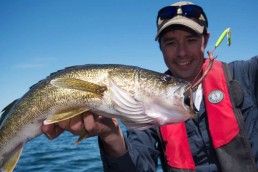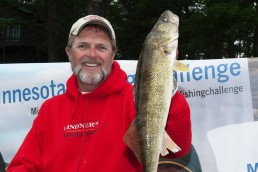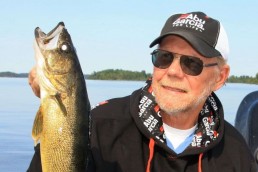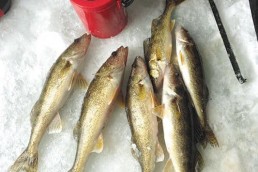Exploring Secondary Spots: Don’t Leave too Soon, Walleyes Likely Lurking
SHARE THIS POST
“They were here yesterday.”
How many times have we heard this or said it ourselves, when fishing? Yours truly is guilty of uttering these words. It’s a fact walleyes move. But when they do it’s rare they travel across a lake overnight. What’s even more common is they shift from one spot to find another, more hospitable zone. Walleyes also move to follow forage.
When walleyes aren’t where we anticipate, branching out beyond a spot and exploring surrounding water in the immediate area is a good tactic for locating fish. The goal is working quickly but being thorough.
Spots vs. areas
A fishing “spot” is a small segment of habitat, like an isolated rock pile on a bar, a reef or clump of cabbage. Areas are larger and more complex. Fishing spots exist within an “area,” not vice versa. A vast grass flat is an example of an area. We’re talking concepts here, so we could also include the shallow, weedy bay and the basin water around this grass flat as part of the larger area.
As anglers, our job is to track down walleyes within their aquatic surroundings. Fishing thoroughly begins by seeing the big picture of an area and recognizing how walleyes relate to different areas for daily and seasonal movements. Walleyes’ time on spots can be short, but they often live in areas for longer periods.
Scenario 1: Connected structures and basin gems
On one lake I fish there’s a basin containing a handful of small islands. The islands’ points are good spots when they’re hit with waves or during low light. One point slowly tapers out to 24 feet before dropping off into 40 feet. One day when exploring the area I learned the point connects to a small reef farther out in the basin—ah-ha! The point turned out to be part of a saddle. During sunny conditions, I’ve caught walleyes more consistently from the reef that tops out at 30 feet than the shallower point. Further exploration also revealed other reefs and boulder strips scattered on a nearby deep flat. Many of these have become reliable zones when shallower structures haven’t been producing fish.
Scenario 2: Weeds near deep water
Weed beds near deep water are common walleye hangouts. A typical pattern is that walleyes hide under the weeds during sunny conditions. Pitching 1/8- to 3/8-ounce jigs into weed openings can produce awesome action. Sometimes in overcast or windy conditions, walleyes cruise the weeds. Here, working weed edges with jigs, diving hard baits and swimbaits will catch them. Then, there are days when nothing seems to work.
Are you enjoying this post?
You can be among the first to get the latest info on where to go, what to use and how to use it!
We’ve said it before in the magazine—a daytime weed-walleye bite is a fickle thing. When it’s on, it’s rocking. When it’s off, you might as well be pitching jigs to rain-filled potholes in a parking lot. So where should anglers look when walleyes aren’t in the salad?
I’ve seen two patterns repeat themselves on several lakes.
The drop-off adjacent to a weed flat leading into a bay is a good place to start. Focus on contour bends or points extending beyond the drop-off; these concentrate fish. Work the top, the slope, and the base of the drop-off. Also, explore the connecting deep flat. Troll spinner rigs on bottom-bouncers or try jigging plastics.
If fish aren’t on the drop-off, check the basin. Walleyes will suspend in a lake basin containing schools of perch or pelagic baitfish. Scanning open water with electronics helps determine if this pattern is taking place. If it is, break out inline planer boards and troll small minnow baits, crankbaits or spinner rigs tipped with worms. Whether these are the same walleyes that forage in the weeds is debatable, but it’s a section of habitat within the larger area where they’ll live and can be caught.
Wetting a line vs. sonar time
The arrival of side and down imaging sonar has changed how many anglers fish, myself included. At one time, covering water meant fishing at a faster pace or doing a lot of back-and-forth reconnaissance with 2D sonar. Now, we’re more efficient; we can scan a massive swath of water on either side of the boat to find fish and structure. You can multi-task, too. Troll the area while scanning sideways and looking for new spots and suspending fish.
Casting an area while eyeing electronics and gazing through the water does still have merit though, and provides another perspective. This approach pays off when walleyes are scattered and roaming on shallow and mid-depth flats. Big-motor scouting can spook fish. Instead try fan-casting swimbaits, crankbaits, jigs, blade baits, spoons or jerkbaits. Work with your fishing buddy to try different lures and retrieve speeds. This can give clues to a walleye’s mood in addition to where they’re located. Keep your eyes peeled for forage and microstructure that may appeal to walleyes in the area. This species will often cycle through a series of spots as part of a larger roaming pattern on a flat. Crack this code and you’re in for some good fishing action.
The long view
While running-and-gunning from one spot to another is beneficial, giving an area a chance to cough up fish before firing up the outboard is also a sound approach. Over time, fishing areas can also lead to a broader understanding of how walleyes behave within large habitat zones. We learn about their daily movements, preferred depth range, seasonal shifts, food base, optimum structure and their favored cover within the water system.
MWO
SHARE THIS POST
Did you enjoy this post?
You can be among the first to get the latest info on where to go, what to use and how to use it!
Tim Allard
Tim Allard is a full-time outdoor journalist and author and photographer of the multi-award-winning book, Ice Fishing––The Ultimate Guide. Follow him on Instagram @timallardtips.



